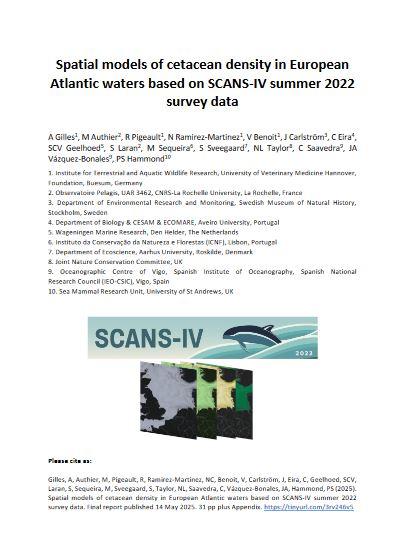Spatial models of cetacean density in European Atlantic waters based on SCANS-IV summer 2022 survey data - Rapport final (mai 2025)

Présentation
The Small Cetaceans in European Atlantic waters and the North Sea surveys (SCANS) are regionally coordinated synoptic surveys that started almost 30 years ago with the aim of monitoring whales, dolphins and porpoises on the shelf and offshore waters of the European Atlantic.
The objective of the SCANS-IV project is to estimate the abundance of cetacean species in shelf and oceanic waters of the European Atlantic through a large-scale multinational aerial and shipboard survey in the summer of 2022. This is the most appropriate survey timing because of the higher probability of good sighting conditions, and also to ensure that results are comparable with those from previous SCANS surveys conducted in 1994, 2005/2007 and 2016 (Hammond et al. 2002, 2013, 2021).
In the context of marine spatial planning, the outputs of habitat-based density models or species distribution models (SDMs) are increasingly used for marine management and conservation applications, including the assessment of potential impacts from a wide range of anthropogenic activities (Hammond et al., 2013; Gilles et al., 2016, Lacey et al., 2022, Pigeault et al., 2024a). The effectiveness of SDMs as conservation management tools is attributed to their capacity to predict spatial and temporal changes in species distribution patterns. Consequently, another major aim of SCANS-IV, and all preceding surveys, was to supply information on summer distribution by modelling the data in relation to environmentally-linked spatial features to generate density surface maps.
In this report, we summarise the development and results of predictive habitat-based models of cetacean density for seven species and two species groups using survey effort and sighting data from the SCANS-IV surveys conducted during summer 2022.

